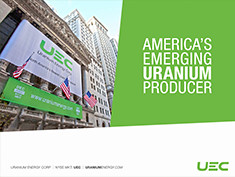Millennium
Millennium
The Millennium Project (“the Project”) is a Joint Venture (JV) between Cameco and Japan (Canada) Exploration Ltd. (“JCU”). UEC has indirect ownership of the project through UEX’s 50% ownership of JCU. The JCU equity in the Project is 30.099% with Cameco Corporation owning the remaining 69.901% and acting as the project operator.
- Uranium resources identified thus far on the project are 75.9 M lb. U3O8 at 2.39% in the Indicated Resource category and 29.0 M lb. U3O8 at 3.19% in the Inferred category for a total combined resource of 104.9 M lb. U3O8.
- UEC attributable resources are 11.42 M lb. in the Indicated Resource category and 4.36 M lb. in the Inferred category.
The deposit is ~300 m long and plunges from the unconformity up to ~150 m into the basement. The deposit is hosted in faulted basement rocks at and below the unconformity. The unconformity in the deposit area is about 600 m below the surface. The deposit was discovered in 2000 and is about 35 km north of Key Lake, ~35km to the southwest of McArthur River, and ~13 km west of the Phoenix and Gryphon deposits at Wheeler River. Access to the project is by a series of trails from the McArthur River – Key Lake haul road.
Like other uranium deposits along the corridor between Key Lake and Rabbit Lake, the Millennium Deposit is located near the transition between the Wollaston and Mudjatik Domains. The Millennium deposit is hosted in faulted basement metasedimentary rocks. The strike of the uranium mineralization is N-S along with the stratigraphy and geophysical conductors. The uranium mineralization is locally upgraded within the deposit envelope where an E-W fault transects the north trending fault and stratigraphy, resulting in the highest grades and thicknesses of uranium mineralization in the Millennium Deposit.
The uranium mineralization is mono-metallic, meaning that it is very low in elements such as arsenic that complicate the milling process. The ore minerals consist largely of uraninite with minor coffinite. Accessory lead and vanadium increase with uranium grade. The uranium occurs dominantly as massive replacement of the host-rocks parallel to the foliation of the rocks, with subsidiary matrix material that infills breccias and veins / veinlets. Alteration outboard of the uranium mineralization is dominantly illite with minor amounts of chlorite, dravite, kaolinite and minor fine-grained hydrothermal quartz. The alteration in the sandstone above the deposit is also dominated by illite with minor amounts of chlorite, dravite, kaolinite and dickite.
Table 1 - Millennium Indicated and Inferred Resources
| Deposit(1) | Ownership Interest | Indicated Resources | Inferred Resources | ||||||
| Tonnes | Grade (wt% U3O8) |
U3O8 (M lb) |
UEC Share (M lb) |
Tonnes | Grade (wt% U3O8) |
U3O8 (M lb) |
UEC Share (M lb) |
||
| Millennium | JCU – 30.099% | 1,442,600 | 2.39 | 75.90 | 11.42(1) | 412,000 | 3.19 | 29.00 | 4.36(1) |
1 UEC share of resources based on 50% indirect ownership of JCU through UEX
Uranium mineralization at Millennium is 104.9 million lb U3O8 combined indicated and inferred resources. UEC’s attributable share of these combined resources is 15.8 million lb U3O8.

